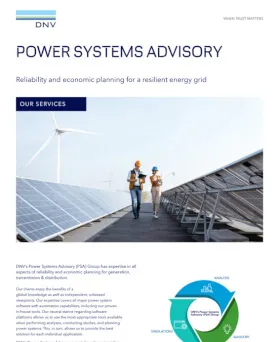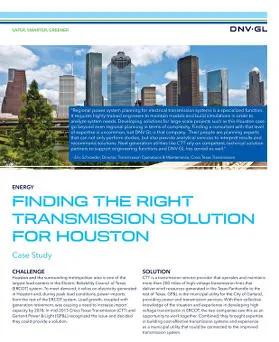Both customers and regulators demand that power disruptions are kept to a minimum. So, if a blackout does occur, a TSO must be able to restore power as quickly, reliably and safely as possible while minimising the stress on network components. This last condition is vital as too much electrical stress from a restart could trigger component failure or protection devices, plunging the network into another blackout and extending the misery for consumers.
Customer
TenneT
Challenge
Dutch TSO TenneT, to comply with its own requirements, needed to increase its level of black start (system restoration) power in the northern Netherlands. TenneT developed a project to use ENGIE’s black start facility at the Bergum power plant and involve ENGIE’s power plants in the Eemshaven area, 72 km to the north-east. Due to this distance, the project faced the challenge of energising the 220 kV / 380 kV grid between Bergum and Eemshaven and starting a large power plant.
Approach
TenneT launched a technical feasibility study of black start functionality in this network. The study was carried out in close collaboration with ENGIE and consultants from DNV.
The study compared three scenarios for system restoration:
- A standard approach based on 3 or 4 black start generators and sequential energisation of network components
- A soft-energisation process with 1 black start generator
- Point on Wave (PoW) switching
In the event of successful energisation, one unit at the Eemshaven power plant would subsequently be started.
Several factors added to the complexity of this black start project:
- Energisation of 72 km (45 miles) unloaded 220 kV overhead line (OHL)
- Reactive power of the unloaded 220 kV overhead lines and 220 kV cables to be handled by a shunt reactor and the black start generator
- Saturation of unloaded transformers (with a total rating of approximately 2000 MVA)
- Transformer remanent magnetism/residual flux at the instant of the black out
- Limited, reactive and short-circuit power capacity of the gas turbine generator that energized the grid
The three approaches were evaluated in a two-stage process. Firstly, load flow calculations assessed the feasibility of the generator(s) absorbing the reactive power in the 220 kV line. Second, transient simulations allowed the energisation of OHLs and transformers to be explored.
Results
Scenario 3 (PoW switching) was discounted after step 1 due to lack of PoW availability in the TenneT network and concerns over the concept’s behaviour after a blackout. The transient simulations then revealed that the standard approach (scenario 1) could cause long-lasting oscillations and saturation when energising cables and transformers, leading to a large risk of component electrical stress and tripping. Hence, it was decided to focus on scenario 2.
Consequently, additional investigations were carried out on how to apply soft energisation in this specific network. These included further simulations, based on a model for both the transmission network and the black start generator and its voltage control, plus live tests on the network itself. As a result, a mitigation measure was developed to further reduce the risk of a generator trip. This mitigation measure demagnetizes transformers connected with the network section, that must then be energized to rated voltage level. During a system restoration live test this demagnetization measure was applied successfully and proven to be effective for the restoration of the high voltage network.


